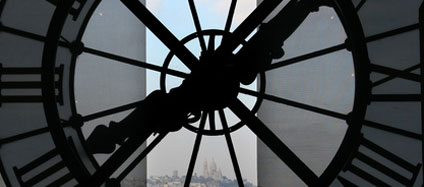Thanks to your guide, you will skip the long lines at the museum’s entrance and you will learn about the interesting history of the building which was an old train station built in 1900 for the World Fair. Today, the museum’s collection spans the artistically revolutionary era between 1848 and 1914.
The Building Itself – Introduction to the Museum :
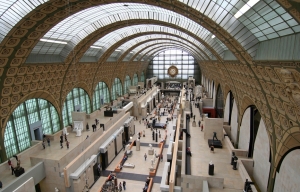 Victor Laloux was the young architect who won the competition to design the Gare d’Orsay. The building itself was inaugurated as a railway station for the 1900 World Fair. It continued to serve the stations of southeast France until 1939, but its platforms became too short for postwar trains and it fell into disuse. The gare d’Orsay was scheduled to be torn down in 1970 but survived and became a landmarked building in 1978. The vast dimensions of this early 20th century building have helped the new project and are ideally suited for a museum. You will be amazed by the abundance of natural light in the whole building. The job of redesigning the interior as a museum was given, in 1986, to the fashionable Milanese architect Gae Aulenty. You will start the visit with the discovery of the main hall bordered by a series of terraces and stepped landings.
Victor Laloux was the young architect who won the competition to design the Gare d’Orsay. The building itself was inaugurated as a railway station for the 1900 World Fair. It continued to serve the stations of southeast France until 1939, but its platforms became too short for postwar trains and it fell into disuse. The gare d’Orsay was scheduled to be torn down in 1970 but survived and became a landmarked building in 1978. The vast dimensions of this early 20th century building have helped the new project and are ideally suited for a museum. You will be amazed by the abundance of natural light in the whole building. The job of redesigning the interior as a museum was given, in 1986, to the fashionable Milanese architect Gae Aulenty. You will start the visit with the discovery of the main hall bordered by a series of terraces and stepped landings.
The Ground Floor : Classicism and Realism
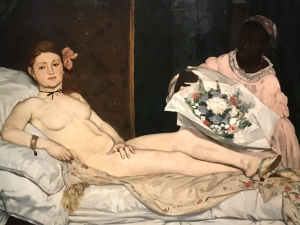 You will first explore the ground floor of the museum which features paintings, sculptures and decorative arts from 1850 to 1870. The ground floor « nave », under the great glass arch, is devoted to pre-1870 work, with a double row of sculptures running down the central aisle like railway tracks. You will discover the influence of the Realists painters, the Barbizon School (with the works of Corot, Millet …) and learn about the birth of modern painting (with the works of Manet, Courbet …)
You will first explore the ground floor of the museum which features paintings, sculptures and decorative arts from 1850 to 1870. The ground floor « nave », under the great glass arch, is devoted to pre-1870 work, with a double row of sculptures running down the central aisle like railway tracks. You will discover the influence of the Realists painters, the Barbizon School (with the works of Corot, Millet …) and learn about the birth of modern painting (with the works of Manet, Courbet …)
The Upper level – Impressionist Territory :
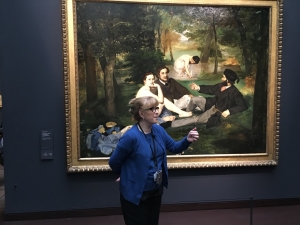 To continue chronologically, your guide will lead you to the upper level, whose rooms have a more intimate feel and dedicated to the impressionists. You will enjoy an amazing view of the city before marveling at some of the most beautiful works of Monet (Femme à l’ombrelle, Rouen cathedral series…) , Renoir (Bal du Moulin de la Galette) or Caillebotte (Raboteurs de parquet). Less typical works include Degas‘ ballet dancers, which demonstrate his principal interesting movement and line as opposed to the more common Impressionist concern with light.
To continue chronologically, your guide will lead you to the upper level, whose rooms have a more intimate feel and dedicated to the impressionists. You will enjoy an amazing view of the city before marveling at some of the most beautiful works of Monet (Femme à l’ombrelle, Rouen cathedral series…) , Renoir (Bal du Moulin de la Galette) or Caillebotte (Raboteurs de parquet). Less typical works include Degas‘ ballet dancers, which demonstrate his principal interesting movement and line as opposed to the more common Impressionist concern with light.
The Middle level – Post-impressionism :
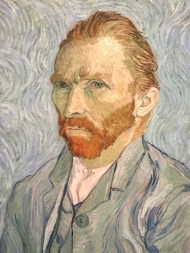 Lastly, discover the middle level with the post-impressionists like Gauguin, Toulouse Lautrec, Seurat, Signac and Van Gogh. Between 1886 and 1900 a more profound and radical modernity was able to develop. Impressionism evolved towards different pictorial approaches. You will finish your tour at the former hotel ballroom where you will be delighted by the sumptuous decor. It was in the ballroom of the station’s hotel that General Charles de Gaulle held the press conference at which he announced his « availability to serve his country » on 19 May 1958, ushering in the end of the French Fourth Republic.
Lastly, discover the middle level with the post-impressionists like Gauguin, Toulouse Lautrec, Seurat, Signac and Van Gogh. Between 1886 and 1900 a more profound and radical modernity was able to develop. Impressionism evolved towards different pictorial approaches. You will finish your tour at the former hotel ballroom where you will be delighted by the sumptuous decor. It was in the ballroom of the station’s hotel that General Charles de Gaulle held the press conference at which he announced his « availability to serve his country » on 19 May 1958, ushering in the end of the French Fourth Republic.
Tickets to the museum are not included.
Build your own trip !!! Flexible Itineraries
Design your own customized tour by building on an existing tour itinerary or creating your own. We’ll help you design your own tour, whether that means coordinating your visit around a special event or adding excursions exclusively. To create your own itinerary email us at steeve@theamericansinparis.com.
We will process your request and get back to you shortly. Thank you.
Category : Museums, Paris by foot
Tags: Impressionism, Monet, Orsay Museum, Paintings, Van Gogh




